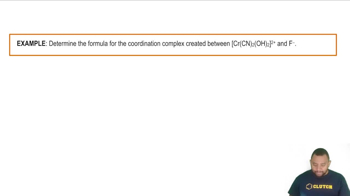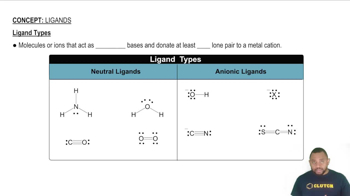Six isomers for a square planar palladium(II) complex that contains two Cl-and two SCN-ligands are shown below.
(a) Which structures are cis-trans isomers?
(b) Which structures are linkage isomers?
 McMurry 8th Edition
McMurry 8th Edition Ch.21 - Transition Elements and Coordination Chemistry
Ch.21 - Transition Elements and Coordination Chemistry Problem 21.87b
Problem 21.87b Verified step by step guidance
Verified step by step guidanceDiastereoisomers are stereoisomers that are not mirror images of each other. In coordination complexes, they arise when there are multiple chiral centers or when the ligands can be arranged in different spatial configurations.
This complex has a coordination number of 6, typically forming an octahedral geometry. The ligands are four water molecules and two chloride ions. Consider the possible arrangements of these ligands around the central copper ion.
In an octahedral complex with two identical ligands (Cl-), the ligands can be arranged in either a cis or trans configuration. The cis configuration has the two chloride ions adjacent to each other, while the trans configuration has them opposite each other.
This complex also has a coordination number of 6, suggesting an octahedral geometry. The ligands are three ammonia molecules and three iodide ions. Consider the possible spatial arrangements of these ligands.
With three identical ligands (NH3) and three identical ligands (I-), the complex can form facial (fac) and meridional (mer) isomers. In the fac isomer, the three identical ligands are adjacent, forming a face of the octahedron. In the mer isomer, the three identical ligands form a meridian, spanning the octahedron.



Six isomers for a square planar palladium(II) complex that contains two Cl-and two SCN-ligands are shown below.
(a) Which structures are cis-trans isomers?
(b) Which structures are linkage isomers?
Which of the following complexes can exist as diastereoisomers?
(a) [Cr(NH3)2Cl4]-
(b) [Co(NH3)5Br]2+
(c) [MnCl2Br2]2- (tetrahedral)
(d) [Pt(NH3)2Br2]2-
Tell how many diastereoisomers are possible for each of the following complexes, and draw their structures.
(a) Pt(NH3)3Cl (square planar)
(b) [FeBr2Cl2(en)]-
Which of the following complexes can exist as enantiomers? Draw their structures.
(a) [Cr(en)3]3+
(b) cis-[Co(NH3)Cl]2+
(c) trans-[Co(en)2(NH3)Cl]2+
(d) [Pt(NH3)3Cl3]+
What is the crystal field energy level diagram for the complex [Fe(NH3)6]3+?
(a)
(b)
(c)
(d)
Draw all possible diastereoisomers of [Cr(C2O4)2(H2O)2]-. Which can exist as a pair of enantiomers?